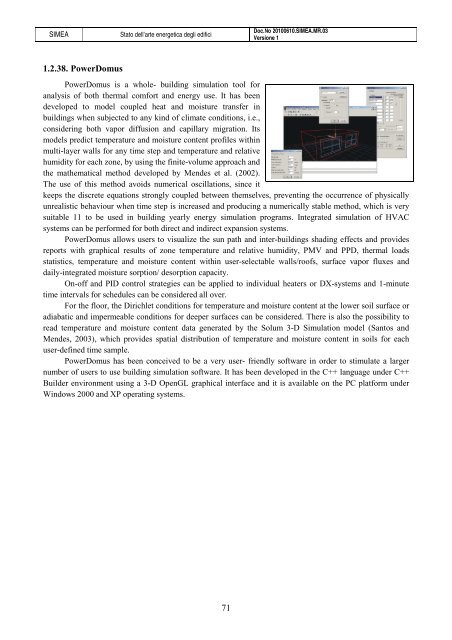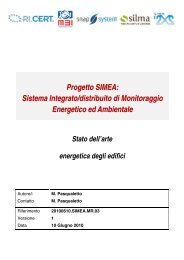Progetto SIMEA - Automatica - Università degli Studi di Padova
Progetto SIMEA - Automatica - Università degli Studi di Padova
Progetto SIMEA - Automatica - Università degli Studi di Padova
You also want an ePaper? Increase the reach of your titles
YUMPU automatically turns print PDFs into web optimized ePapers that Google loves.
<strong>SIMEA</strong> Stato dell’arte energetica <strong>degli</strong> e<strong>di</strong>fici<br />
1.2.38. PowerDomus<br />
71<br />
Doc.No 20100610.<strong>SIMEA</strong>.MR.03<br />
Versione 1<br />
PowerDomus is a whole- buil<strong>di</strong>ng simulation tool for<br />
analysis of both thermal comfort and energy use. It has been<br />
developed to model coupled heat and moisture transfer in<br />
buil<strong>di</strong>ngs when subjected to any kind of climate con<strong>di</strong>tions, i.e.,<br />
considering both vapor <strong>di</strong>ffusion and capillary migration. Its<br />
models pre<strong>di</strong>ct temperature and moisture content profiles within<br />
multi-layer walls for any time step and temperature and relative<br />
humi<strong>di</strong>ty for each zone, by using the finite-volume approach and<br />
the mathematical method developed by Mendes et al. (2002).<br />
The use of this method avoids numerical oscillations, since it<br />
keeps the <strong>di</strong>screte equations strongly coupled between themselves, preventing the occurrence of physically<br />
unrealistic behaviour when time step is increased and producing a numerically stable method, which is very<br />
suitable 11 to be used in buil<strong>di</strong>ng yearly energy simulation programs. Integrated simulation of HVAC<br />
systems can be performed for both <strong>di</strong>rect and in<strong>di</strong>rect expansion systems.<br />
PowerDomus allows users to visualize the sun path and inter-buil<strong>di</strong>ngs sha<strong>di</strong>ng effects and provides<br />
reports with graphical results of zone temperature and relative humi<strong>di</strong>ty, PMV and PPD, thermal loads<br />
statistics, temperature and moisture content within user-selectable walls/roofs, surface vapor fluxes and<br />
daily-integrated moisture sorption/ desorption capacity.<br />
On-off and PID control strategies can be applied to in<strong>di</strong>vidual heaters or DX-systems and 1-minute<br />
time intervals for schedules can be considered all over.<br />
For the floor, the Dirichlet con<strong>di</strong>tions for temperature and moisture content at the lower soil surface or<br />
a<strong>di</strong>abatic and impermeable con<strong>di</strong>tions for deeper surfaces can be considered. There is also the possibility to<br />
read temperature and moisture content data generated by the Solum 3-D Simulation model (Santos and<br />
Mendes, 2003), which provides spatial <strong>di</strong>stribution of temperature and moisture content in soils for each<br />
user-defined time sample.<br />
PowerDomus has been conceived to be a very user- friendly software in order to stimulate a larger<br />
number of users to use buil<strong>di</strong>ng simulation software. It has been developed in the C++ language under C++<br />
Builder environment using a 3-D OpenGL graphical interface and it is available on the PC platform under<br />
Windows 2000 and XP operating systems.
















